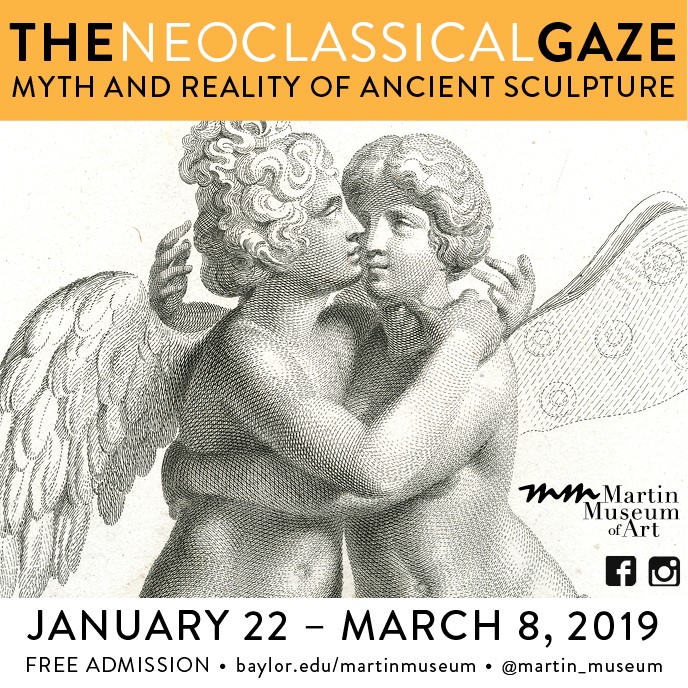Baylor’s Martin Museum Will Open 2019 with “The Neoclassical Gaze: Myth and Reality of Ancient Sculpture” Exhibition

Baylor University's Martin Museum of Art will present The Neoclassical Gaze: Myth and Reality of Ancient Sculpture from Jan. 22 through March 8 in the Hooper-Schaefer Fine Arts Center, 60 Baylor Ave.
Media Contact: Lori Fogleman, Baylor University Media and Public Relations, 254-710-6275
Follow Lori on Twitter: @LoriBaylorU
Follow us on Twitter: @BaylorUMedia
by Jessie Jilovec, student newswriter, Baylor University Media and Public Relations
WACO, Texas (Jan. 22, 2019) – Baylor University’s Martin Museum of Art will present The Neoclassical Gaze: Myth and Reality of Ancient Sculpture from Jan. 22 through March 8 in the Hooper-Schaefer Fine Arts Center, 60 Baylor Ave. The exhibition will feature Wilhelm Gottlieb Becker’s Augusteum, a three-volume publication of engravings that illustrate ancient Greek and Roman sculpture.
The works will be examined from the perspectives of the ancient world and the Neoclassical Revival at the turn of the 19th century, presented by guest curators Sean DeLouche, Ph.D., lecturer of art history, and Nathan Elkins, Ph.D., associate professor of art history.
Allison Chew, director of the Martin Museum, said the exhibition provides an opportunity to think beyond one’s own experiences and view the works with a fresh perspective of the cultures that created it.
“I’m excited to see the intersection of ancient Greek and Roman culture, 18th century interpretation of said cultures, and the clarification of the misconceptions created surrounding the artwork found in the exhibition,” Chew said. “I think the public will have a great opportunity to unpack this concept and step outside their perceptions to see the original intent of ancient artwork, how we contextualize it over time and how we often ‘get it wrong.’”
DeLouche said the exhibition came about by happenstance. After new museum staff came across a pile of roughly 100 prints not recorded into the museum’s collection, staff approached DeLouche and Elkins about identifying the prints. They researched the works and discovered they had been cut out of the Augusteum, published in Germany in 1804 to 1811. The museum tracked down the complete volumes and purchased them.
The exhibition will feature about 80 loose prints in frames alongside the complete volumes. The museum also will display a complete volume of Leplat's engravings of the Dresden antiquities from 1733 to compare with the Augusteum prints. The volume comes to Baylor on special loan from the University of Chicago.
The museum also will display 19th-century plaster casts of ancient statues from the Blanton Museum of Art in Austin. The exhibition includes a photograph of a Baylor art studio class in 1909 showing students drawing from plaster casts.
Elkins said the contents of the exhibit cover similar ground as many of the art history courses taught, giving a great opportunity for students.
“In survey-level courses, ancient sculpture is still treated from the perspective of form, style, aesthetic and artistic attribution,” Elkins said. “These concerns go back to the Neoclassical period and before, and still exert influence on the study of ancient art today. Part of the exhibit explores how these focuses misdirect study of the ancient past and have projected a false sense of reality onto the ancient past. The community should find much to consider in this exhibit as we explore both modern (Neoclassical) and ancient ways of looking at Classical sculpture.”
The Augusteum is a grand publication dedicated to the ancient sculpture collected by Augustus II, the Prince Elector of Saxony, in Dresden, Germany, during the mid-18th century.
DeLouche said this exhibit is the most ambitious exhibition the Martin Museum has mounted in its history.
“There is so much for the viewer to appreciate – the fine lines of the print engravings, the powerful presence of the plaster casts, which have been brought out of storage in the Blanton, the history of the ancient world and of the turn of the 19th century, biographies of interesting characters like antiquarian J. J. Winckelmann and Prince Augustus the Strong, love stories like that of Antinous and Hardian, discussions of crafts like printmaking and casting and more,” DeLouche said.
During the height of Dresden’s popularity in the 19th century, Becker, the publisher of Augusteum, led tours of the “Collection of Antique and Modern Sculptures” for visitors by torchlight, while wearing dark and heavy robes for dramatic appeal. In conjunction with the exhibition, the Martin Museum will host a Valentine’s Day event that will include torchlit guided tours, Valentine printmaking, live music and hors d’oeuvres.
All exhibitions and special events at the Martin Museum are free and open to the public. For more information or to register for a Valentine’s tour, call 254-710-6371 or visit the Martin Museum website.
ABOUT MARTIN MUSEUM OF ART AT BAYLOR UNIVERSITY
The Martin Museum of Art at Baylor University is committed to the advancement and understanding of art through an active program of collections, stewardship, conservation, innovative exhibitions, education, interpretive programs and special events to serve and enrich Baylor University and the public communities of Waco and Central Texas. The Museum serves as a vital resource for teaching and scholarship in a broad variety of disciplines, including art history, art appreciation, studio art and more. For more information, visit www.baylor.edu/martinmuseum.
ABOUT BAYLOR UNIVERSITY
Baylor University is a private Christian University and a nationally ranked research institution. The University provides a vibrant campus community for more than 17,000 students by blending interdisciplinary research with an international reputation for educational excellence and a faculty commitment to teaching and scholarship. Chartered in 1845 by the Republic of Texas through the efforts of Baptist pioneers, Baylor is the oldest continually operating University in Texas. Located in Waco, Baylor welcomes students from all 50 states and more than 80 countries to study a broad range of degrees among its 12 nationally recognized academic divisions.